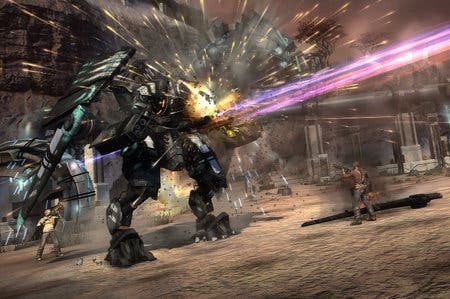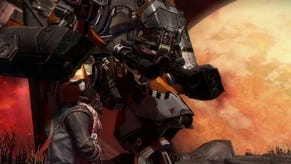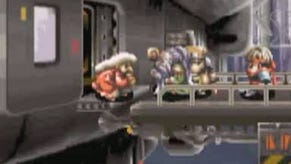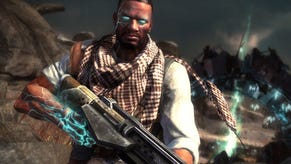Digital Foundry vs. Starhawk
LightBox's mutliplayer shooter under the microscope.
With its massive scale online battles, sprawling environments and combination of vehicular combat and third-person shooting, Warhawk became one of the early highlights of PlayStation 3 gaming - released in late 2007 when there was nothing quite like it on either of the current generation consoles.
Starhawk - the game's anticipated sequel - feels very much the same: the intense 32-player battles remain fully intact, as do the trademark aerial and ground-based combat, but the setting has shifted into a gritty sci-fi universe, with the gameplay cleverly augmented with mild real-time strategy elements.
The Build and Battle system sees players being able to creates launching pads, armouries, anti-air defences and more, adding a whole new level of strategy to the multi-layered gameplay already on offer. This creates an air of unpredictability in tried and tested game modes such as Capture the flag and Team Death Match as players experiment with different ideas during heated online conflicts.
But at the end of the day, it's the Hawks that are the stars of the show: hybrid mechs that transform into deadly weapons of aerial destruction. Starhawk's most exciting moments come when in the air, surrounded by multiple players, engaged in a dynamic ballet of bullets above the far-reaching environments. The superb dog-fighting is the defining element that makes this sequel so much fun to play. Starhawk may lack striking new innovations, but its core elements are superbly realised and the raw experience can be quite breathtaking.
All of this takes places on wide open environments where the player is given complete freedom to explore. This is the first element which draws you into the game: the landscapes featured in Starhawk are both large and highly detailed, with superb view distance. Canyons and mountainsides often tower above the player when on the ground, and even smaller maps feel rather generous in terms of space depending on how they are viewed. The video below should give you a good impression of just how much of the terrain is openly available.
Landscapes are littered with fine detail which only increases in clarity upon closer inspection; the intricacies found in the artwork are more cleanly brought to the surface than they were in Warhawk. Texture resolution is visibly higher across the board, and the liberal use of normal mapping creates added depth and complexity across many surfaces throughout the game. Various effects also help to give each area a unique feel, with a number of elements such as pockets of heat haze, smoke and lightning setting the tone.
Starhawk: A Technical Perspective
Considering the size and detail of the stages it is pleasantly surprising to find a general lack of noticeable pop-up occurring as higher quality assets are displayed on screen. This is a feat made possible by utilising the PlayStation 3's hard drive in order to stream graphics data into RAM at much faster speeds than the system's Blu-Ray drive allows. The 2.6GB installation only takes a few minutes to complete and the end results are worth the short wait: bar the odd instance, transitions between LODs appear smooth in motion and this adds a sense of consistency to the game world, helping to keep you immersed in the action.
Backing this up is the way in which developer LightBox uses the available technology to help create atmosphere, intensity and spectacle during combat. The engine allows the game to throw out a ton of smoke, debris and explosions which litter the screen when things are being blasted to pieces. Partially damage a Hawk in mid-air and smoke pours out; shoot at it some more and it bursts into flames; deliver the final blow and it comes crashing into the ground, exploding in view full of other players, if not directly on them. Frequent use of camera and object-based blur is also used liberally throughout the game, further generating a sense of ferocity while giving the presentation a cinematic feel.
The intensity of the action is underpinned with an impressive soundtrack taking inspiration from various sci-fi films and TV shows, such as Serenity, The Chronicles Of Riddick and Firefly, with some very Star Wars-esque sound effects prominently being used throughout - particularly for the Hawks, which sound similar to TIE Fighters as they whizz past the camera after being shot down.
"Frequent use of camera and object-based blur is also used liberally throughout the game, further generating a sense of ferocity to the proceedings while giving the presentation a cinematic feel."




From a visual perspective, a few compromises have been made in order to allow these epic battles to be realised without putting too much pressure on the hardware. Low resolution alpha buffers are used for many of the game's effects - a decision most likely taken to ensure that the RSX GPU's peak bandwidth limit isn't exceeded. As a result, smoke, fire, and similar elements which form the game's layered explosions can appear soft and blurry up close, with jaggies being created when the low res buffers intersect with higher resolution geometry. This is partially negated by the developers' use of a post-process anti-aliasing solution, which actually smooths over some of the offending edges to a degree.
On the other hand, trees and foliage which are scattered across the environments appear to utilise higher resolution buffers, but a different compromise is reached here: these elements of the scene are the first to be pared back as the transitions between levels of detail occur.
Starhawk comes across as a pretty clean-looking game, but one that also seems a little soft in its appearance. Looking at the framebuffer, native 720p resolution has been dropped in favour of a sub-HD presentation - 1152x640, or thereabouts - with a post process anti-aliasing algorithm being used instead of a hardware solution. Interestingly, the HUD elements are also upscaled as well, with edge smoothing being applied after the final framebuffer is completed.
Thankfully, the implications of this are not completely unpleasant, especially when you consider the amount of detail in the environments that comes through fairly unscathed. In all fairness, images appear quite smooth and pleasing to the eye, and most aliasing artifacts are kept under control, bar some mild sub-pixel shimmering. Our only complaint is that a strong edge detection algorithm does blur the artwork to some degree - causing the foliage to take on a low resolution appearance as a result - although this doesn't completely tarnish the overall look of the game.
To an extent the added softness works quite well with the gritty sci-fi setting, and low resolution textures aside, it's really only from a distance that we feel that fine details are really being scrubbed away.
"Native 720p resolution has been dropped in favour of a sub-HD presentation - 1152x640, or thereabouts - with a post process AA solution in effect."
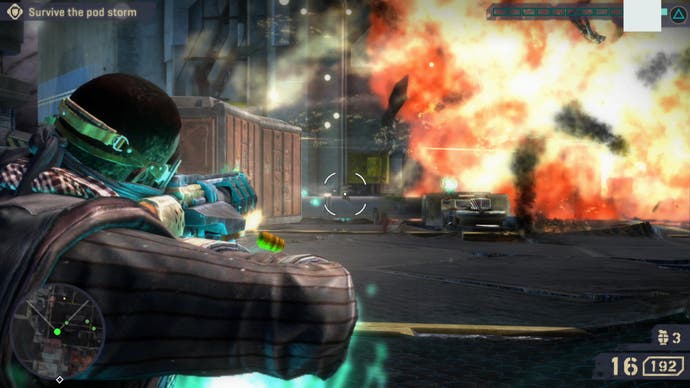

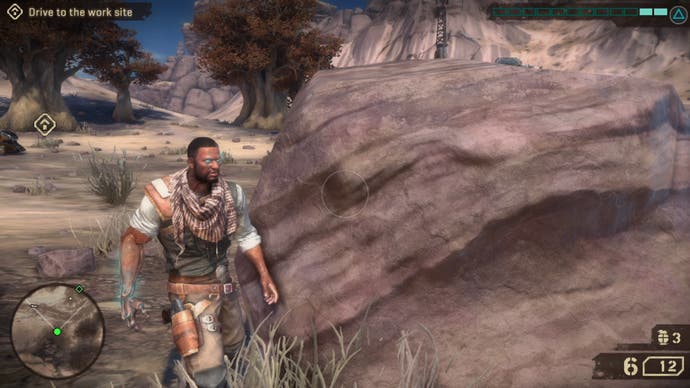

One of the most interesting elements to make its way into Starhawk from a gameplay perspective is the ability to erect various structures in real-time throughout both single- and multiplayer modes. These can be used to give players extra vehicles, new weapons, base defences, and more. While the system provides the game with an enticing hook that has the potential to keep players interested in the title for months to come, the interactive nature of the battlefield also has an impact on the visuals - in particular with regard to the lighting model, which has to accommodate 'on the fly' changes made by players as they blast each other to pieces.
Dynamic light sources are everywhere, from gunfire and explosions, to the flaming jet engines of the Hawks - environments can be lit up with a myriad of lights from a variety of sources. Furthermore, player-created buildings also cast shadows based on their position in relation to the sun - something that applies to all dynamic objects in the game - and these shift across the landscape and change shape as construction takes place.
Additionally, light shafts are present, with the rays shifting colour as they shine through transparent objects - a rather nice touch even if the effect is actually just a clever illusion. The inclusion of screen-space ambient occlusion (SSAO) polishes off the lighting model: the effect is present on both characters and the environments, adding subtle depth to the scene without causing visible haloing around the objects affected.
Performance Analysis
The scale of the environments, the maximum number of players on-screen, and the vast number of visual effects can put a strain on LightBox Interactive's accomplished game engine. In order to effectively manage performance without disrupting the gameplay experience too much, most console developers usually target a 30FPS update, dropping v-sync in order to maintain performance - at the expense of having some screen-tear appear when the renderer cannot meet the demands of the game.
By doing this, image consistency takes a bit of hit, but it helps keep controller response relatively consistent - particularly important in a fast-paced multiplayer shooter. With Starhawk, LightBox has decided to go with a very different approach to tackle these issues. Here we are presented with a triple-buffer set-up (where a frame is held in reserve should the first one be torn), and an uncapped frame-rate. The idea is to deliver the player as many frames as possible without incurring any unwanted tearing. Our first performance video gives you a good example of what to expect during the single-player campaign.
"Starhawk utilises a triple-buffer set-up and an uncapped frame-rate, which works really well when the engine is operating in optimal conditions but does lack consistency when the engine is under stress."
It's clear that LightBox's solution actually works well when the engine isn't being taxed too heavily. Tearing is completely absent from the game, while the frame-rate naturally settles at a steady 40FPS when there is little to challenge the engine - essentially this appears to be the threshold for how fast frames can be rendered without incurring a drop in performance.
Perhaps rather surprisingly, when the game is temporarily running at a near-continuous 40FPS we get the feeling that the frame-rate is smoother than it really is, which has a positive impact on how responsive the controls feel and how fluid the action appears. The extensive use of camera and object motion blur helps the human eye to literally blend frames into each other, which in turn is partially responsible for the smooth movement we are seeing.
Perhaps the only real downside of adopting this set-up is that there is a sense of inconsistency in frame-rate when the action is really intense. In really chaotic scenes, where there are dozens of players on-screen, along with plenty of alpha effects, performance can drop down to the mid-twenties resulting in a noticeable loss in controller response and visible judder. It is possible to adjust to a certain degree to this, but the quality of the experience does suffer even if the visual spectacle is quite superb.
Performance online largely mirrors that of the single-player campaign, albeit with a tangible difference. The drops in frame-rate are slightly more severe when the engine is put under heavy load - especially where the large space battles are concerned - and this translates into a noticeably more uneven gameplay experience. Scenes on the ground also tend to stabilise at 30FPS, rather than at 40FPS in quieter moments, although the engine is frequently capable of rendering out scenes at higher frame-rates in areas where the draw distance is smaller, or if there are only a handful of players on-screen.
"In really chaotic scenes, where there are dozens of players on-screen, performance can drop down to the mid-twenties resulting in a noticeable loss in controller response and visible judder."
Overall, the level of performance we see in both modes is generally acceptable given the heavy demands placed upon the engine, although the inconsistency caused by the frequently fluctuating frame-rate can be distracting. However, for the most part Starhawk still remains a comfortably playable online experience - just one that isn't completely free from a few niggling performance issues.
Starhawk: The Digital Foundry Verdict
Five years after the release of Warhawk, its sequel presents itself as a very similar title in which the core gameplay remains relatively unchanged. This is hardly a bad thing in itself - the intense aerial encounters are as addictive as ever, and the Build and Battle system generally makes combat more interesting and unpredictable. The foundation of the game is rock solid and it's safe to say LightBox Interactive has delivered one of the most entertaining PS3 multiplayer games released for quite some time.
The technology underpinning the experience also manages to impress. Large environments and battles are crammed with dynamic light sources, generous use of alpha and particle effects - all of which help to deliver a sense of spectacle and intensity to heated single- and multiplayer games. Of course, there are a few stumbling blocks along the way. Performance could be smoother when the engine is put under stress, and the sub-HD framebuffer in combination with an overly aggressive post-process anti-aliasing solution can makes things appear softer than we'd like.
In terms of gameplay criticism, the campaign mode feels held back by the limitations of being based around training players for the online game - the main event, if you will. The limited number of environments is enough to sustain prolonged multiplayer matches as the nature of unpredictable human competition keeps things interesting, but drawn-out battles against bots won't hold your attention for long. We also feel that the combination of different gameplay styles also could have been developed a little further, with more building and weapon choices being a good starting point.
That said, the game is clearly geared towards online play and in this respect, the experience more than delivers - which makes its lowly debut in 17th position on the UK sales chart both mystifying and somewhat disappointing. It's a beautiful game that's superb to play and it's exclusive to PlayStation 3 - we highly recommend you check it out.
